Currencies
Information
More Information
US Uniform Buttons
US Military Uniform Button Identification
A uniform button's use and age is principally determined by three characteristics, usually considered together. First the "device" (design) identifies the service or state militia that used it, and generally when it was used. Keep in mind that certain devices were used for many decades, so other clues are needed. The buttons construction also offers a guide to age. Finally, the back mark may not only indicate the manufacturer, but if a particular mark or the manufacturer was in existence for a narrow time period, you can further pin down the likely age and use of a button.Some rules of thumb of age can be made as to how the shank is attached. A one-piece button with a brazed shank (soldered appearance) is a design common in the 18th century, but was also made after. A two-piece button with a brazed shank is typical of 19th century. Two pieces crimped together were first made about 1813. Two-piece hollow rounded buttons held together by a thin rim ("staff" buttons) were invented in the 1830s and used until 1902. Civil War era buttons may show a circular depression at the base around the shank. Shanks inset into holes in the button is typical after World War I. Tinned Iron Back (TIB) and stamped brass turret back buttons are common from the 1880s to 1920s. Sometimes one of the best indicators of button age is the manufacturers back marks.
Many button manufacturers of course made non-military uniform buttons, generally called "fashion" buttons. Antique military buttons will typically have an eagle, anchor, or state seal design. Fashion buttons can have many motifs ranging from floral, scroll, or even patriotic designs that might be confused with military buttons. Sometimes private company buttons (like train companies) might be confused with military uniform buttons. Generally military uniform buttons of the Civil War era and earlier command the highest prices, and are in more demand that fashion or private company uniform buttons.
Modern Era US Military Branch Buttons and Insignia
Collectors will most often come across modern era US military buttons. The image below shows the design of each of the four principal military branches. Generally, brass buttons represent dress uniform buttons, and black buttons are field uniform buttons. These buttons generally came in three sizes: jacket cuff (25-ligne or 5/8-inch), jacket (36-ligne or 9/32-inch), and coat (45-ligne or 1 1/8-inch). The US Army, and US Marines button design and manufacture have changed little since the since the turn of the twentieth century. The US Navy officer button has not changed since 1941, when the eagle went from facing to its left, to facing to its right, and the US Air Force buttons have changed little since the branch was created until after the end of World War II (1945). There are some collectible variants in all branches before the Korean War (1950s) relating to composition, design, and back marks, but post Korean War buttons have little collector value, other than as a replacement on a modern uniform. Our explainer page of Great Seal Buttons has more information about 20th century US Army buttons.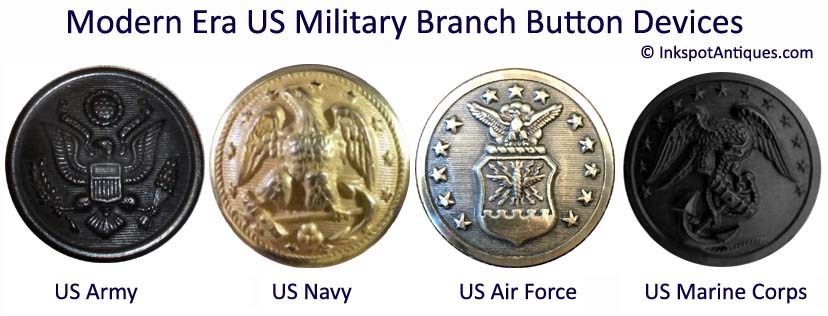
US Army buttons did change a number modest design changes during the 19th Century, and the image below can be used as guide on identifying the age of buttons between the Civil War and about 1910. Some of the most collectable are those that contain that reference the division of the army on the eagles' shield, with I representing the Infantry, C the Calvary, A the Artillery, and D the Dragoons, among others (see the detailed timeline below). US Navy buttons between 1851 and 1941 look nearly identical to today's buttons, except the eagle faces to its left during that period (viewer's right), and in 1941, it changed to facing to its right. There are some interesting and collectible variants in the design and manufacture of these earlier US Navy buttons, and some of the civil War era variants can be quite collectable.

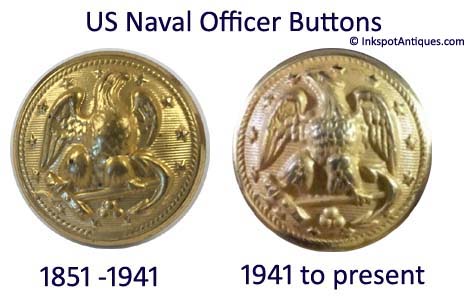
Scovill Buttons
Prior to and during the Civil War, Scovill was the most prolific button manufacturers. The Scovill name is common on buttons from the 1830 to the 1970s. The original Scovill partnerships and companies were located in Waterbury, CT, so often the name Waterbury also appears on Scovill buttons. The brothers J. M. Lamson Scovill and William Henry Scovill operated the business from 1827 to 1840. These buttons are generally marked "JML Scovill..." or "Scovills". The Scovills & Co backmark is found from around 1840 to 1850. Marks with variations of Scovill Manufacturing begin about 1850 (Scovill MG.- early 1850s, Scovill MF'G - mid 1850s). Below are some of the many Scovill backmark variations. Please consider the dates as typical periods. Scovills reused certain backmarks for decades, so the specific lettering alone cannot be used to date their buttons.LEVENWORTH, HAYDEN & SCOVILL (also as LH&S) 1811-1827
J.M.L. & W.H. SCOVILL 1827-1840
J. M. L. & W. H. SCOVILL / [dot] WATERBURY [dot] / EXTRA SUPERFINE [dot] [star] [dot] [star] [dot] [star] [dot] 1830s. Example: Republic of Texas infantry
J M L & W H SCOVILL / [star] EXTRA RICH [star] 1830s. Example: South Carolina militia
SCOVILLS : 1827-1840
SCOVILLS [dot] Waterbury [dot] [two inner rings of dots] 1830s US Dragoons [Eagle with D]
SCOVILLS / [dot] WATERBURY [dot] [RMDC between solid rings, outer ring of short rays, flat back] 1830s Example: US Artillery [Eagle with D]
SCOVILLS [star] Waterbury [star] [two inner rings, one piece] 1830s Example: US Topographical Engineers
SCOVILLS & CO / [dot] WATERBURY [dot]" [stippled background] 1840s and 1850s
SCOVILL MG. CO. [dot] 1850s. Example US Navy
SCOVILLS & CO. : 1840-1850
SCOVILL MANUFACTURING CO. : 1850-1960
SCOVILL Mg. Co.: 1850-1865
SCOVILL Mg. Co. / WATERBURY CT. 1850-1865
SCOVILL Mf'g Co. : WATERBURY CT. 1850-1865 for raised letters in a depressed channel, others through 1902
SCOVILL Mf'g Co. WATERBURY : 1850-1865 for raised letters in a depressed channel, others can be much later
SCOVILL Mfg Co. WATERBURY Con. : 1850-1865 for raised letters in a depressed channel, others can be much later
SCOVILLS [dot] Waterbury [dot] Typically Civil War or earlier, especially RMDC types. Example: So. Carolina militia button
SCOVILLS [star] WATERBURY [star]: pre Civil War (typically RMDC backmark), and Civil War and post Civil War (typically DM backmark)
Backmark Acronym Definitions
There are a two acronyms commonly seen when button backmarks are described.RMDC: Backmarks with a raised mark in a depressed channel. These generally date to the 1830s to 1850s.
DM: Depressed marks (the lettering looks hand stamped into the metal). These typically date to the 1860s and later.
Caveats
Keep in mind that using Scovill backmark lettering (including dots and stars) is not a foolproof method because Scovill often used old backmark dies to make newer buttons. Thus it is possible to have a World War I "Great Seal" button with an 1850 backmark. Another nuance is that while text may remain the same, other embellishments on Scovill buttons change with time. An 1850 backmark may have the name in a groove or one or two rings made of fine lines or tiny dots, whereas a later button may have no ring of dots (like the Great Seal general service button below).Here are Scovill examples of late buttons with old backmarks that we have observed:
SCOVILL MF'G CO. WATERBURY CT. 1872-1902 (on GI 98, ring of large dots)
SCOVILL MF'G CO. * WATERBURY *: 1902-est. 1918
(on Great Seal coat buttons with ring of large dots)
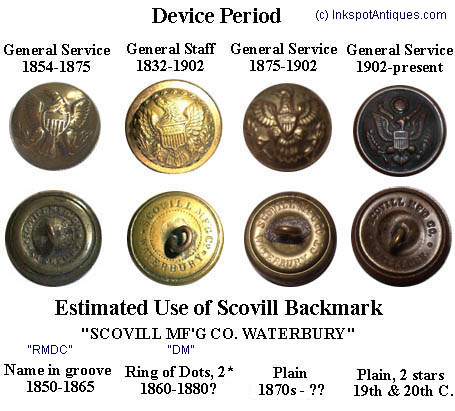
Timeline of Key US Army General Infantry Button Devices
Based upon Albert (1976)General Service 1852-1902: (enlisted men) Two-piece buttons with spread eagle and lined shield
1852-1875: shield not raised, coat size 19-20 mm typ
1875-1902: shield conspicuously raised, coat is 21 mm
General Service 1902-present: (enlisted men and officers) Great Seal of the US. One and two-piece buttons. See list of "Great Seal" button marks.
Shields with Letters
Shield with I : Infantry. Enlisted men, 1821-1854, officers 1821-1902.
Shield with A : Artillery. Enlisted men, 1821-1854, officers 1821-1902.
Shield with R : Riflemen. Enlisted men, 1821-1857, officers 1821-1902.
Shield with C : Calvary, 1855-1902 (officers only).
Shield with D : Dragoons (a light cavalry), 1836-1854 for enlisted men, officers 1836-1902.
Modern Buttons, Non-military Buttons, and Reproductions
Millions of buttons are manufactured every year, and many modern U.S. military buttons lack backmarks. Army and Navy officer buttons from the Korean War, Vietnam War, many used in World War II, and those used today are mostly indistinguishable. These modern U.S. military buttons have little value, except as replacements for lost buttons (if they are in good enough condition). Some military designs, like the navy anchor, eagle on anchor, fouled anchor, and the older army officer eagle were always popular on non-military clothing. If you purchased a blue blazer with brass buttons in much of the 20th century, the fashion buttons would often be of an eagle or anchor motif similar to military uniform buttons. These military styled buttons are sometimes passed off as military uniform buttons today, but their designs do not precisely match the military designs, and they typically lack the detail and quality found in regulation uniform buttons. Adding to the confusion was that some manufacturers, like Waterbury, used the same backmarks for decades on military, private company uniform, and brass fashion buttons. Sometimes foreign buttons get mixed up and added to collections. German Navy buttons are a type that often go unrecognized.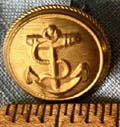 Even some military button references appear to contain errors. Tice shows a Scovill button with a design of a fouled anchor with a rope border, similar to the one pictured here (TICE NA 236), and stating Chief Petty Officers started using these buttons about 1840. This is nonsensical, because the U.S. Navy did not create the rank of Chief Petty Officer rank until 1893. Albert shows the same button as NA131, but does not attribute a date, but still identifies it as a Chief Petty Officer button. However, no website devoted military uniform history, nor any of the historical texts make any mention of Chief Petty Officers wearing a unique style coat button. In fact, regulations from 1905 and 1922 posted online state Chief Petty Officers are to use same buttons as the other officers, although on one coat, it is a slightly different size.
Even some military button references appear to contain errors. Tice shows a Scovill button with a design of a fouled anchor with a rope border, similar to the one pictured here (TICE NA 236), and stating Chief Petty Officers started using these buttons about 1840. This is nonsensical, because the U.S. Navy did not create the rank of Chief Petty Officer rank until 1893. Albert shows the same button as NA131, but does not attribute a date, but still identifies it as a Chief Petty Officer button. However, no website devoted military uniform history, nor any of the historical texts make any mention of Chief Petty Officers wearing a unique style coat button. In fact, regulations from 1905 and 1922 posted online state Chief Petty Officers are to use same buttons as the other officers, although on one coat, it is a slightly different size. Finally, button manufacturers are manufacturing authentic-looking antique military buttons for military reenactment groups and societies. While the designs of these buttons are generally accurate, their quality and detail in the design is usually inferior to the originals, and the backings are very different. A Google Search for Civil War reenactment brass buttons will provide a sense of popular antique U.S. military buttons.
Do you think any of this information is wrong? Then please send us feedback.
Copyright © 2025 Inkspot Antiques and Collectibles. Powered by Zen Cart

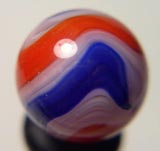 Buy Akro Agate Popeye marbles on eBay!
Buy Akro Agate Popeye marbles on eBay!